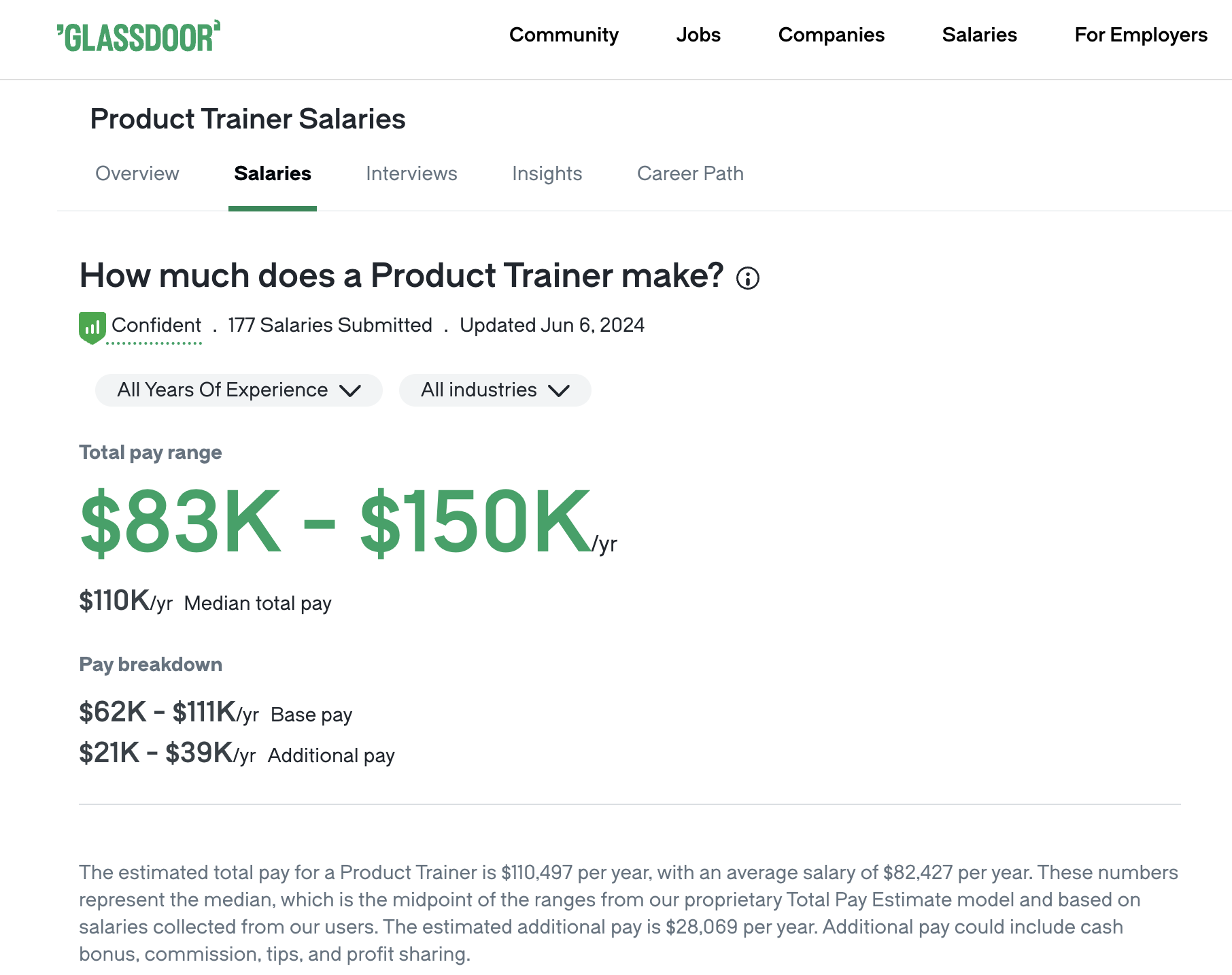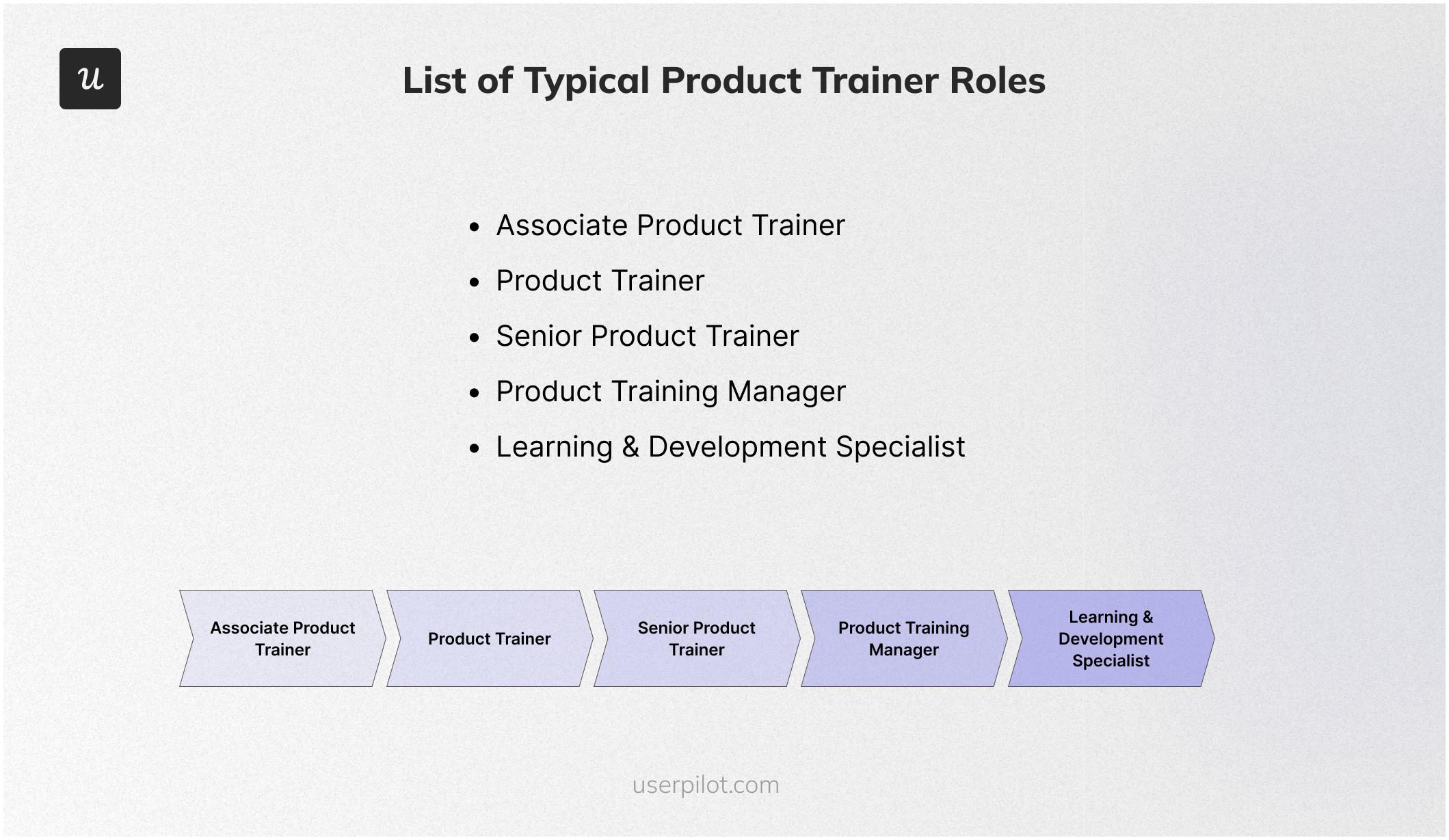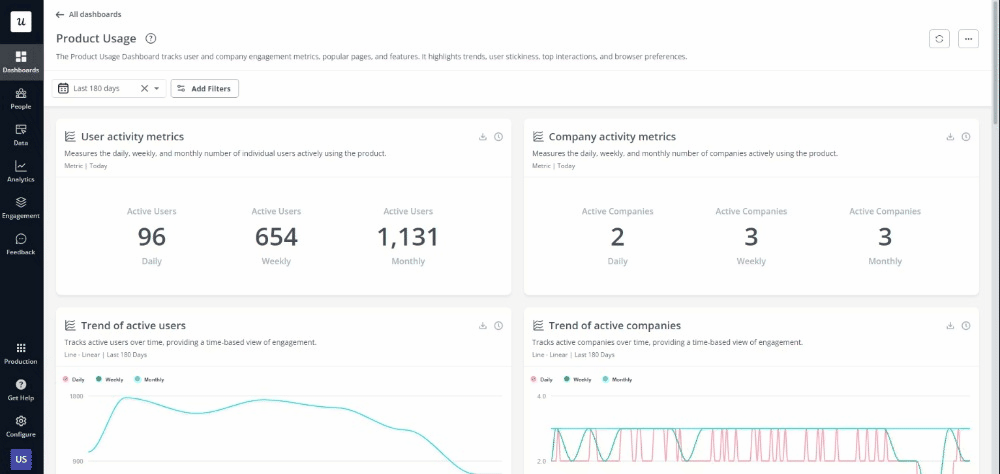![Product Trainer Salary [+ Resources to Advance]](https://blog-static.userpilot.com/blog/wp-content/uploads/2024/07/Product-Trainer-Salary-Resources-to-Advance.png)
Product Trainer Salary [+ Resources to Advance]9 min read
Understanding the salary landscape for product trainers is crucial whether you’re entering the field or looking to advance your career.
In this guide, we’ll provide an overview of typical product trainer salaries, explore factors that can influence earnings, and share valuable resources to help you progress in your career.
Let’s get started!
Get The Insights!
The fastest way to learn about Product Growth, Management & Trends.
TL;DR
- A product trainer is a specialist who educates people about a company’s products or services.
- According to popular hiring platforms like Glassdoor, the average salary for a product trainer in the US falls between $65,000 and $80,000 annually.
- Becoming a great product trainer requires a mix of expertise, empathy, and effective communication. Here are some best practices to help you excel in this role:
- Start with the “Why”
- Cater to different learning styles
- Provide real-world context
- Offer ongoing support
- Gather feedback and iterate
- Stay updated on product changes
- Looking into tools for product trainers? Userpilot is an all-in-one product platform with engagement features and powerful analytics capabilities. Book a demo to see it in action!
What is a product trainer?
A product trainer is a specialist who educates people about a company’s products or services. They can train various audiences, including:
- New employees: Equipping them with the knowledge to effectively use the product within the company.
- Sales teams: Helping them understand the product’s features and benefits to better sell it to customers.
- Customers: Providing them with the knowledge to use the product to its full potential.
Product trainer’s main responsibilities
Product trainers play a crucial role in ensuring that employees, customers, or partners understand and effectively use a company’s products or services. Their responsibilities are diverse and can vary depending on the industry, company size, and product complexity. However, here are some core duties:
- Design and develop training materials, including presentations, workshops, webinars, e-learning modules, and hands-on exercises.
- Deliver engaging and informative training sessions tailored to different audiences and learning styles (i.e. onboarding new employees and customers on product usage).
- Troubleshooting technical issues and providing product support.
- Stay up-to-date on product updates, new releases, and industry trends.
- Gather feedback from trainees and stakeholders to assess training needs and identify areas for improvement.
How much does a product trainer make?

According to popular hiring platforms like Glassdoor, the average salary for a product trainer in the US falls between $65,000 and $80,000 annually.
However, this is just a starting point. Several factors can significantly influence a product trainer’s salary.
For example, entry-level trainers earn around $45,000-$55,000 annually, while those with 6+ years of experience can command upwards of $70,000.
Location also impacts earnings, with major tech hubs like San Francisco, New York City, and Seattle offering higher compensation packages compared to smaller cities.
Product trainer career path

The product trainer role offers a rewarding career path with opportunities for advancement. Here’s a roadmap outlining potential progression paths:
- Associate Product Trainer (1-3 years): Assist senior trainers with user onboarding, create training materials, and gain a strong understanding of the product.
- Product Trainer (3-5 years): Design and deliver comprehensive training programs for various user groups using your training skills and product knowledge.
- Senior Product Trainer (5+ years): Lead and manage a team of trainers, develop training strategies, and ensure high-quality training experiences.
- Product Training Manager (7+ years): Oversee the entire product training function, manage budgets, and ensure training aligns with business goals.
- Learning & Development Specialist (8+ years): Lead the broader learning and development function, encompassing product training and other areas like employee onboarding.
Best practices to be a great product trainer
Becoming a great product trainer requires a mix of expertise, empathy, and effective communication. Here are some best practices to help you excel in this role:
- Start with the “Why”: Begin by explaining the value proposition of the product. Why should learners care? How will it help them or their organization? This sets the context and motivates them to learn.
- Cater to Different Learning Styles: Don’t just lecture. Incorporate a variety of teaching methods like demos, interactive guidance, gamifications, and quizzes to appeal to different learning styles.
- Provide Real-World Context: Use case studies, examples, and scenarios to show how the product is used in real-world situations. This helps learners connect the dots and see the practical applications of what they’re learning.
- Offer Ongoing Support: Don’t just end the training with a Q&A session. Provide resources like documentation, FAQs, or a community forum where learners can get ongoing support and answers to their questions.
- Gather Feedback and Iterate: Regularly collect feedback from learners to evaluate the effectiveness of your training. For example, you can send a post-onboarding survey to measure user satisfaction. Use this feedback to refine your materials, delivery, and overall approach.
- Stay Updated on Product Changes: Products evolve constantly. Make sure your training materials are always up-to-date and reflect the latest features and functionalities.
Best resources for product trainers
Product trainers play a crucial role in driving user adoption and ensuring the success of any product. Here are some of the best resources for product trainers, categorized to help you find exactly what you need:
Best books for product trainers
To excel in this role, continuous learning and development are essential. Here are five books highly recommended for product trainers, covering various aspects of training, product management, and customer success:
- “Telling Ain’t Training” by Harold D. Stolovitch & Erica J. Keeps: A classic on the science of adult learning and how to design effective training programs.
- “Design for How People Learn” by Julie Dirksen: Explores cognitive science principles and translates them into actionable strategies for creating engaging learning experiences.
- “The Lean Product Playbook” by Dan Olsen: Provides a framework for building products that customers love, with valuable insights for trainers on understanding customer needs and validating product ideas.
- “The Effortless Experience” by Matthew Dixon, Nick Toman & Rick DeLisi: Provides a framework for delivering low-effort customer experiences and improving customer loyalty.
- “The Challenger Sale” by Matthew Dixon & Brent Adamson: Offers insights on how to challenge customers’ assumptions and create buying urgency, relevant for trainers involved in sales enablement.
Best webinars for product trainers
Webinars offer a convenient and accessible way to gain valuable insights, learn new strategies, and connect with industry experts. Here are some highly recommended webinar sources for product trainers:
- Userpilot Events: Focuses on product growth and user onboarding, crucial for understanding user behavior and crafting effective training programs. Their webinars cover topics like user journey optimization, feature adoption analytics, and user engagement strategies – all feeding directly into your training initiatives.
- Mind the Product Webinars: Known for their high-quality webinars on various product management topics, including training and onboarding. Their sessions often feature industry experts sharing their knowledge and experience.
- Pragmatic Institute Webinars: Provides webinars on various aspects of product management, including training and development. Their sessions often focus on practical skills and real-world scenarios.
- Product-Led Growth Collective Webinars: This community-driven platform offers webinars on various aspects of product-led growth, including user onboarding and product adoption.
Best blogs for product trainers
Here are some of the best blogs for product trainers, offering practical guides, expert interviews, and actionable advice:
- Userpilot Blog: Offers in-depth guides, case studies, and actionable advice on creating effective onboarding experiences, improving product adoption, and driving user engagement.
- Product Talk: Features interviews with product leaders and experts, offering insights into their strategies and tactics. Covers a wide range of industries and company sizes.
- Roman Pichler’s Blog: Offers in-depth articles and resources on applying agile methodologies to product management. Provides valuable insights for trainers who want to create flexible and adaptable training programs.
- ProductPlan Blog: Provides practical advice and templates for creating effective product roadmaps. It also offers insights into prioritizing features, aligning stakeholders, and communicating product strategy.
Best podcasts for product trainers
Curious about what the top product trainers are listening to? These are the podcasts generating buzz in the community, packed with insights and discussions to help you stay updated:
- The Product Experience: Hosted by product experts Lily Smith and Randy Silver, this podcast goes deep with industry leaders, covering a wide range of topics relevant to training, including user onboarding, product adoption, and customer success.
- Rocketship.fm: It is a great podcast for getting inspired and motivated. It’s packed with stories of entrepreneurs who have overcome challenges and built amazing products.
- Masters of Scale: Hosted by Reid Hoffman (co-founder of LinkedIn), this podcast explores how companies grow from zero to a gazillion. While not directly focused on training, it offers valuable lessons on scaling products and building successful teams.
- The Knowledge Project: Hosted by Shane Parrish, this podcast features in-depth conversations with experts from various fields. Trainers can gain insights into topics relevant to their work, such as learning, communication, and decision-making.
Best tools for product trainers
As a product trainer, leveraging the right tools can make all the difference in delivering high-quality, impactful training experiences.
So here are the top 10 tools that product trainers can use to create effective training programs:
- Userpilot: Userpilot is your one-stop shop for creating smooth and engaging user onboarding experiences. With interactive walkthroughs, targeted messages, and personalized guidance, you’ll have users mastering your product in no time. The data-driven insights also help you continuously refine your training strategy.
- Pendo: This product experience platform provides deep insights into how users interact with software. By understanding user behavior and gathering feedback, trainers can tailor their materials to real user needs and drive product improvements.
- Appcues: A low-code user onboarding platform that works for both web and mobile applications. It simplifies the creation of intuitive walkthroughs and tooltips.
- UserGuiding: Similar to Appcues, UserGuiding also offers user surveys and NPS tools. This enables trainers to gather valuable feedback during the onboarding process.
- WalkMe: Reduces the need for manual support by guiding users through complex tasks and processes. It also comes with AI chatbots to provide real-time assistance.
- Usetiful: Usetiful’s flexibility allows trainers to create a variety of training materials for different stages of the user journey.
- HelpHero: It is a knowledge base platform that allows you to build a self-service resource center for users.
- HelpScout: It is a customer support platform with a robust help desk and live chat features.
- Intercom: Intercom allows trainers to proactively engage with users and offer personalized support with targeted messages and AI chatbots.
- Spekit: Spekit is a just-in-time learning platform that integrates with various tools to deliver contextual training and knowledge reinforcement.
Conclusion
Now that you have a better understanding of the salary range for a product trainer position, you can take steps to improve your earning potential.
Consider pursuing relevant certifications, developing your skillset, or negotiating effectively during the job offer stage.
Looking into tools for product trainers? Userpilot is an all-in-one product platform with engagement features and powerful analytics capabilities. Book a demo to see it in action!








